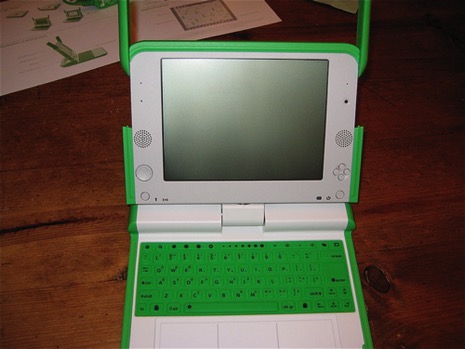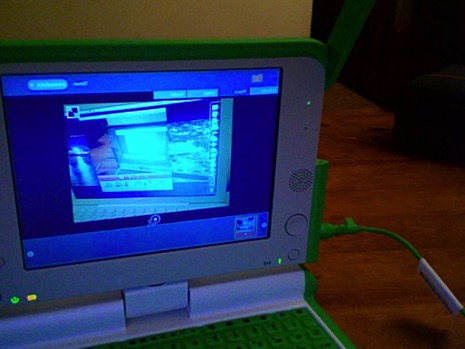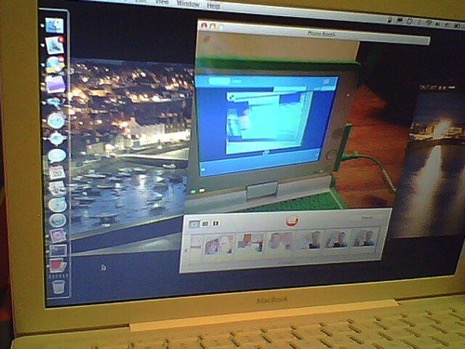Bye Bye OLPC XO
Monday, 21 January 2008
So, I ended up putting my OLPC XO up on eBay. Some nice chap from Mexico picked it up for far too much.
I felt good about the donation part of the Give One Get One program, but not so good about adding $400 to my ever mounting AMEX bill. I had some grand ideas for working on some Python apps for it, playing with the Sugar frontend, and some other stuff. But, I realized over the Christmas break that I really wasn't going to have the kind of time to dedicate to it that would be required. Also, my kids are spoilt by access to nothing slower than a PowerMac G4, and so there wasn't much to offer on the XO that they didn't already have quicker access to, with better input devices, and a better screen, on the Mac.
Now, that's not to say that I don't think that the XO is a worthwhile device. I think it will be useful to its target audience: children who likely would not have the opportunity to be directly exposed to information technology otherwise. And as the interfaces get a little more polished, and the selection of applications expands, it will become more and more useful. I saw recently that John Negraponte intends to sell the XO officially in the US, as opposed to just via the Give One Get One program that I acquired it through. The success of the Asus Eee PC shows that at least some portion of the populous has cotton on to the fact that they don't need the resources of the supercomputers-in-PC-clothing that are now available from Dell et al. I do think they will still want something a little swifter than the XO, but perhaps in the educational setting it might just do okay.
I wish it well.
I felt good about the donation part of the Give One Get One program, but not so good about adding $400 to my ever mounting AMEX bill. I had some grand ideas for working on some Python apps for it, playing with the Sugar frontend, and some other stuff. But, I realized over the Christmas break that I really wasn't going to have the kind of time to dedicate to it that would be required. Also, my kids are spoilt by access to nothing slower than a PowerMac G4, and so there wasn't much to offer on the XO that they didn't already have quicker access to, with better input devices, and a better screen, on the Mac.
Now, that's not to say that I don't think that the XO is a worthwhile device. I think it will be useful to its target audience: children who likely would not have the opportunity to be directly exposed to information technology otherwise. And as the interfaces get a little more polished, and the selection of applications expands, it will become more and more useful. I saw recently that John Negraponte intends to sell the XO officially in the US, as opposed to just via the Give One Get One program that I acquired it through. The success of the Asus Eee PC shows that at least some portion of the populous has cotton on to the fact that they don't need the resources of the supercomputers-in-PC-clothing that are now available from Dell et al. I do think they will still want something a little swifter than the XO, but perhaps in the educational setting it might just do okay.
I wish it well.
OLPC XO First Impressions
Thursday, 20 December 2007
My OLPC XO arrived today! I managed to pry it from the kids when they went to bed and started mucking around with it.

It's a little slower than I was expecting (not that I was expecting it to be swift or anything), and the soft keyboard takes a little getting used to, but on the whole I'm liking it. The industrial design is great in my opinion, and has some neat little touch: the texturing in the case has large nobbles, and around the handle the nobbles become Xs, so that the texturing repeats the XO logo. The Sugar UI feels good and the included apps, a.k.a. Activities, provide a good cross section of functionality, from word processing to recording video on the built-in camera.
The browser, which is Firefox derived, works well and even has some Flash support (via Gnash). It also has some integration with Sugar, since when I went to upload a photo to Flickr and hit the Browse button, a popup appeared showing my last few activities, including the picture I had taken. When I clicked on it, it inserted a /tmp path to a JPEG file into the form. Alas, when I hit the Ok button Flickr told me that the file was empty. I popped into the shell and could the file in question was indeed empty, but there was a non-empty JPG also in temp. I copied it to the path the browser was pointing at (I couldn't get it to let me edit he path in the browser for some reason), and this time the upload worked. I'm sure that's either just a kink or something I didn't do properly when saving the photo.
My MacBook looking at the XO:

My XO looking at my MacBook (the photo referred to above):

The Neighborhood page in Sugar showed my home wireless network's SSID, but I couldn't figure out how to connect to it. I have since found out that you just need to click on the dot representing the network, but I expected there to be a "Connect..." option in the popup dialog that appears when you hover the mouse over the dot. In any case I use WPA and, at least according to the OLPC "getting connected" page, "we do not support WPA-enabled WiFi access points; we anticipate including WPA support in early 2008." However, I did some googling and found that I could drop to the shell to get WPA working (see http://wiki.laptop.org/go/WPA_Manual_Setting). I created the script suggested, ran it, and rebooted the XO, and it came up on my WPA network.
Some of the Activities require more than one XO. Fortunately, one of my colleagues at work ordered an XO the day after me, so his ought to be here soon. I'd particularly like to try out the Distance Activity,

which can measure the distance between two laptops by measuring the length of time it takes for sound to travel between them, but since it requires 2 XOs, it'll have to wait until we both can get them into the office after the holidays.
For more photos of the XO, see the unboxing set I put on Flickr.

It's a little slower than I was expecting (not that I was expecting it to be swift or anything), and the soft keyboard takes a little getting used to, but on the whole I'm liking it. The industrial design is great in my opinion, and has some neat little touch: the texturing in the case has large nobbles, and around the handle the nobbles become Xs, so that the texturing repeats the XO logo. The Sugar UI feels good and the included apps, a.k.a. Activities, provide a good cross section of functionality, from word processing to recording video on the built-in camera.
The browser, which is Firefox derived, works well and even has some Flash support (via Gnash). It also has some integration with Sugar, since when I went to upload a photo to Flickr and hit the Browse button, a popup appeared showing my last few activities, including the picture I had taken. When I clicked on it, it inserted a /tmp path to a JPEG file into the form. Alas, when I hit the Ok button Flickr told me that the file was empty. I popped into the shell and could the file in question was indeed empty, but there was a non-empty JPG also in temp. I copied it to the path the browser was pointing at (I couldn't get it to let me edit he path in the browser for some reason), and this time the upload worked. I'm sure that's either just a kink or something I didn't do properly when saving the photo.
My MacBook looking at the XO:

My XO looking at my MacBook (the photo referred to above):

The Neighborhood page in Sugar showed my home wireless network's SSID, but I couldn't figure out how to connect to it. I have since found out that you just need to click on the dot representing the network, but I expected there to be a "Connect..." option in the popup dialog that appears when you hover the mouse over the dot. In any case I use WPA and, at least according to the OLPC "getting connected" page, "we do not support WPA-enabled WiFi access points; we anticipate including WPA support in early 2008." However, I did some googling and found that I could drop to the shell to get WPA working (see http://wiki.laptop.org/go/WPA_Manual_Setting). I created the script suggested, ran it, and rebooted the XO, and it came up on my WPA network.
Some of the Activities require more than one XO. Fortunately, one of my colleagues at work ordered an XO the day after me, so his ought to be here soon. I'd particularly like to try out the Distance Activity,

which can measure the distance between two laptops by measuring the length of time it takes for sound to travel between them, but since it requires 2 XOs, it'll have to wait until we both can get them into the office after the holidays.
For more photos of the XO, see the unboxing set I put on Flickr.
Playing with the OLPC XO Emulator
Saturday, 17 November 2007
While I wait for my XO to arrive (as they stated, there's no ship date yet), I thought I'd give the emulator a go. Conveniently the laptop.org site has a no-brainer startup guide on the OLPCWiki for running the XO emulator on the Mac (and others) using a port of QEmu to the Mac called Q.app. (I first tried building qemu via MacPorts but it wanted to use GCC 3.3 and 10.5.1 has GCC 4.0; I didn't fancy pulling in the old compiler just for this.)
I downloaded Q.app and a recent build of the XO emulator disk image -

I didn't mess around with the emulator's DPI settings as suggested, so it looked a little fuzzier than the real thing would. Paint wouldn't start for me, but the word processor, chat program, browser, and other things I tried did. Some, like the chat program and connect 4 game needed other XO users to be in your neighbourhood, and for some strange reason there wasn't anyone else running the XO emulator on my rural street at 2am; weird huh?
I'm excited for it to arrive. I wish I could have gotten a couple to be able to have them talk to each other, but I was pushing my luck getting one, never mind two. One of the guys at work is thinking about getting one as part of the Give One Get One program. I'll have to try and persuade him so our XOs have someone to play with.
I downloaded Q.app and a recent build of the XO emulator disk image -
olpc-redhat-stream-development-build-542-20070801_0412-devel_ext3.img and configured a VM as per the instructions on the OLPCWiki. It started up first time, asked me for my name and I was in. Here's a view of the main page:
I didn't mess around with the emulator's DPI settings as suggested, so it looked a little fuzzier than the real thing would. Paint wouldn't start for me, but the word processor, chat program, browser, and other things I tried did. Some, like the chat program and connect 4 game needed other XO users to be in your neighbourhood, and for some strange reason there wasn't anyone else running the XO emulator on my rural street at 2am; weird huh?
I'm excited for it to arrive. I wish I could have gotten a couple to be able to have them talk to each other, but I was pushing my luck getting one, never mind two. One of the guys at work is thinking about getting one as part of the Give One Get One program. I'll have to try and persuade him so our XOs have someone to play with.
One Laptop Per Child: Give One Get One
Monday, 12 November 2007
The OLPC Give One Get One program starts today. For a donation of $399 (plus $24.95 shipping), they will send one XO laptop to "empower a child in a developing nation" and "receive one for the child in your life in recognition". $200 of that $399 is tax-deductible and T-Mobile is throwing in a free year's access to their HotSpot service, which is in of itself worth $360.
I ordered mine today. Even though I don't use my laptop at Starbucks that much, I'll get some use out of the HotSpot service and I would really like to see OLPC get off the ground and do well. There's some truly innovative technology in there - see David Pogue's video for more details - and it's all good old-fashioned open source. How could I say no?

I ordered mine today. Even though I don't use my laptop at Starbucks that much, I'll get some use out of the HotSpot service and I would really like to see OLPC get off the ground and do well. There's some truly innovative technology in there - see David Pogue's video for more details - and it's all good old-fashioned open source. How could I say no?
